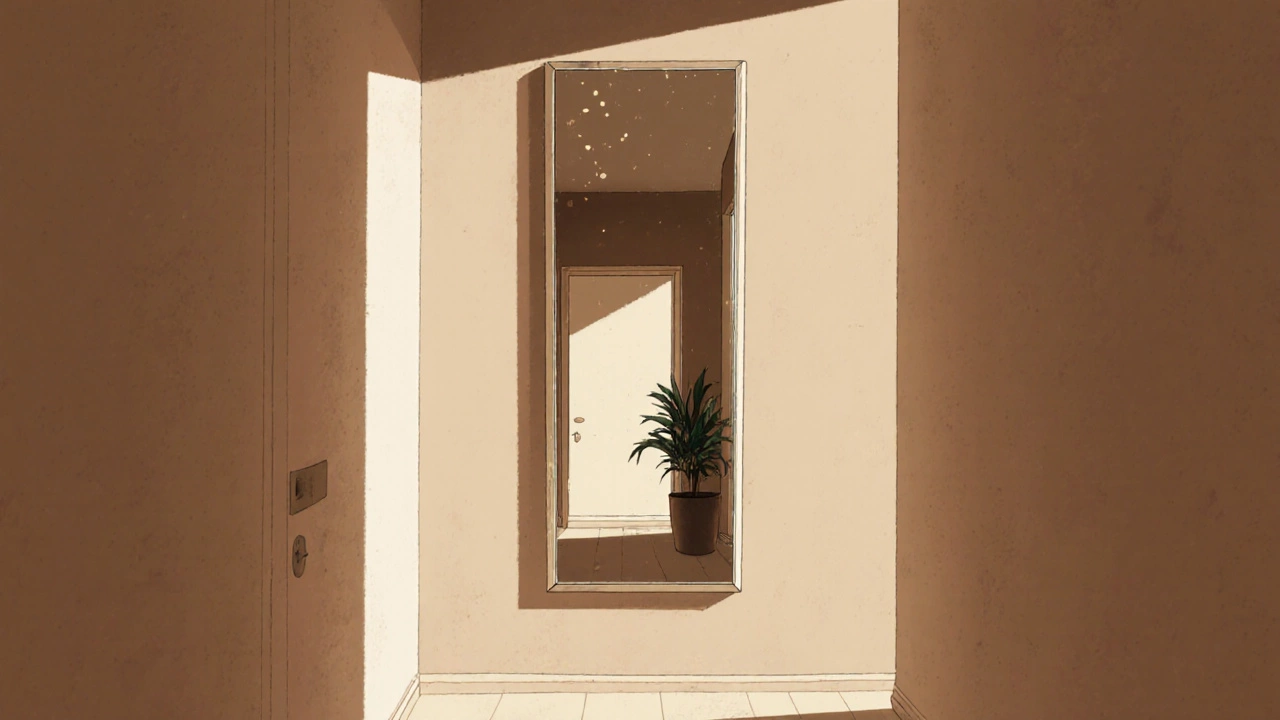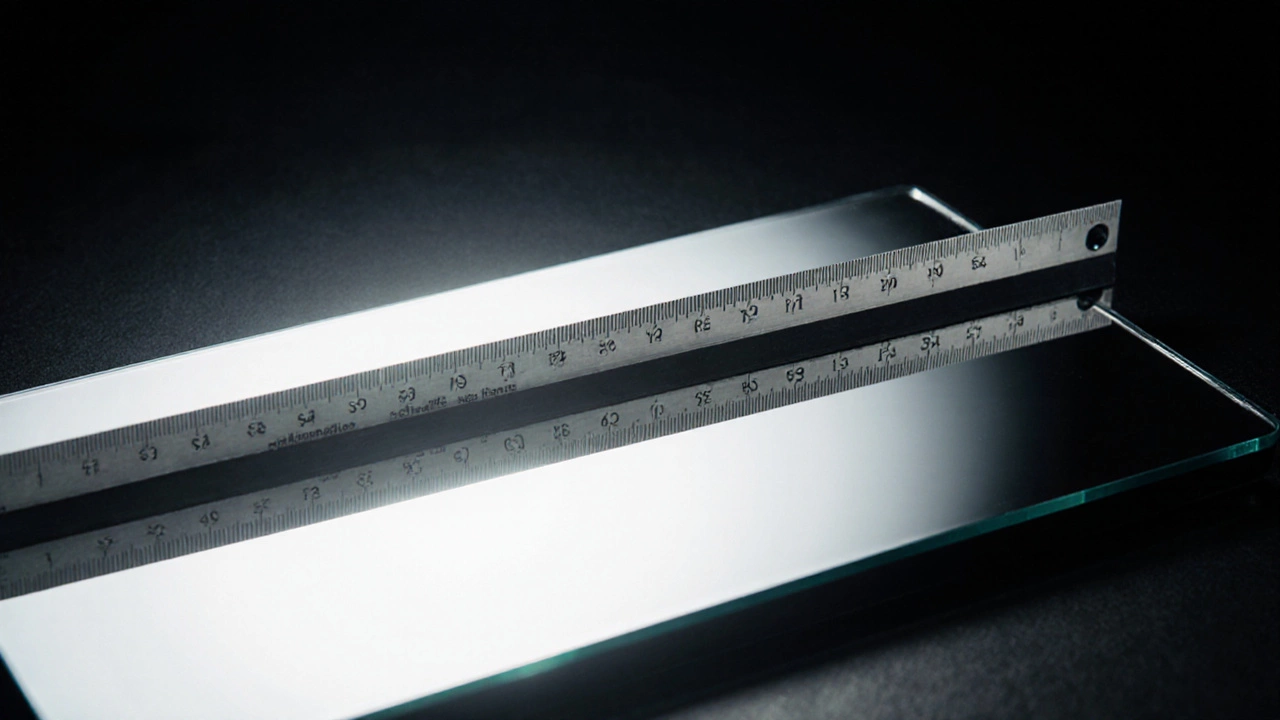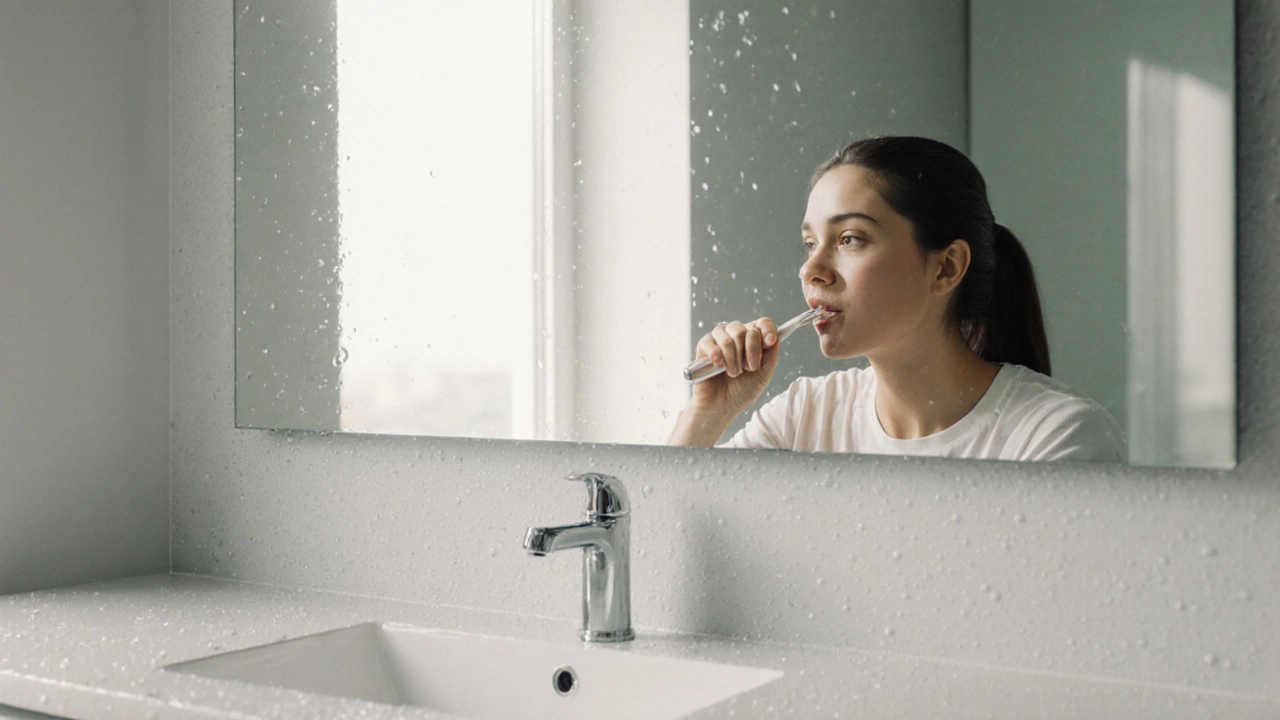Ever looked into a bathroom mirror and wondered why it doesn’t warp your face like a funhouse mirror? That’s because it’s not just any mirror-it’s a plane mirror. This is the most common type of mirror you’ll find in homes, dressing rooms, and even cars. But most people don’t know what it’s actually called. They just call it a mirror. And that’s fine for everyday use. But if you want to understand how light works, why your reflection looks normal, or how to pick the right mirror for your space, you need to know the real name: plane mirror.
What exactly is a plane mirror?
A plane mirror is a flat, smooth surface that reflects light without distorting it. It’s made of glass with a thin layer of metal-usually aluminum or silver-coated on the back. This coating is what makes it reflective. Unlike curved mirrors, which bend light to magnify or shrink images, a plane mirror keeps everything exactly as it is. Your face in a plane mirror is the same size as your real face. Your height? Unchanged. Your left hand still appears on the left side of the reflection. That’s the defining trait of a plane mirror: it produces a virtual, upright image that’s the same size and distance behind the mirror as the object is in front of it.
This isn’t just theory. Try this: stand two feet away from your bathroom mirror. Your reflection looks like it’s two feet behind the glass. Step back another foot-your reflection steps back too. No stretching, no squishing. That’s plane mirror physics in action. It’s why these mirrors are perfect for checking your outfit, brushing your teeth, or making sure your hair is straight before leaving the house.
Why do people confuse flat mirrors with other types?
Because not all mirrors are flat. You’ve seen the others. The ones in amusement parks that make you look tall and skinny or short and wide? Those are concave or convex mirrors. Concave mirrors curve inward, like the inside of a spoon. They can magnify your face, which is why makeup mirrors sometimes use them. Convex mirrors curve outward, like the side mirror on a car. They give you a wider view but make things look smaller. That’s why your car’s side mirror says, “Objects in mirror are closer than they appear.”
But a flat mirror? No tricks. No illusions. Just pure, honest reflection. That’s why it’s called a plane mirror. The word “plane” comes from geometry-it means a flat, two-dimensional surface. So a plane mirror is literally a mirror that sits on a flat plane. Simple. Direct. No fluff.
Where are plane mirrors used in real life?
You’re surrounded by them. In your bedroom, you probably have a full-length mirror on the closet door. That’s a plane mirror. The small one above your sink? Plane mirror. The one in your hallway that makes your space feel bigger? Also a plane mirror. Even the reflective surface on your smartphone’s camera flash? That’s a tiny plane mirror, helping direct light.
They’re also used in science and engineering. Periscopes in submarines use two plane mirrors angled at 45 degrees to let you see above water without surfacing. Optical labs use them to redirect laser beams. Even in solar energy systems, plane mirrors help focus sunlight onto collectors. They’re not flashy, but they’re reliable.
In home design, plane mirrors are a go-to for creating the illusion of space. A mirror on one wall of a small living room can make the room feel twice as big. That’s why interior designers love them. They’re cheap, easy to install, and do exactly what they’re supposed to-reflect light and space without adding distortion.

Are all flat mirrors plane mirrors?
Yes-if they’re truly flat. But not every mirror that looks flat actually is. Some cheap mirrors have slight warps or bubbles in the glass. These aren’t true plane mirrors. They create tiny distortions. You might notice your reflection looks slightly stretched in one corner, or your face looks a little crooked. That’s not the mirror’s design-it’s a manufacturing flaw.
True plane mirrors are made with precision. High-quality ones use optically flat glass, often tempered for safety. The coating is applied evenly. The backing is sealed to prevent tarnishing. That’s why a $20 mirror from a discount store might look fine at first, but after a year, the edges start to darken or the reflection gets fuzzy. A good plane mirror lasts decades.
How to tell if your mirror is a true plane mirror
Here’s a simple test you can do at home:
- Place a ruler flat against the mirror surface.
- Look at the reflection of the ruler.
- If the ruler in the reflection lines up perfectly with the real ruler-no bending, no warping-you’re looking at a true plane mirror.
- If the reflection looks bent or curved, even slightly, it’s not optically flat.
You can also try the “fingernail test.” Put your fingertip against the mirror. If there’s no gap between your nail and its reflection, it’s a front-surface mirror (rare in homes). But if you see a small gap-about the width of a pencil lead-that’s because the reflective coating is on the back. That’s normal for most household plane mirrors. The gap is caused by the thickness of the glass. It doesn’t mean the mirror isn’t a plane mirror. It just means it’s a standard back-silvered glass mirror, which is what 99% of homes use.

Plane mirrors vs. other mirrors: a quick comparison
| Mirror Type | Surface Shape | Image Type | Common Uses |
|---|---|---|---|
| Plane Mirror | Flat | Virtual, upright, same size | Bathrooms, bedrooms, dressing rooms, home decor |
| Concave Mirror | Curved inward | Can be real or virtual, magnified | Makeup mirrors, telescopes, headlights |
| Convex Mirror | Curved outward | Virtual, smaller, wider field | Car side mirrors, security mirrors in stores |
As you can see, plane mirrors are the baseline. Everything else is a variation. They’re the default. The standard. The one you don’t think about-until you start wondering why your reflection doesn’t look weird.
Why does this matter for home decor?
If you’re choosing a mirror for your home, knowing it’s a plane mirror helps you make smarter choices. You don’t need a fancy curved mirror to make your room look better. A simple, well-made plane mirror does the job without tricking your eyes. It reflects light naturally, which brightens dark corners. It creates depth, which makes small rooms feel open.
And because it doesn’t distort, it’s the only mirror you should use for tasks that require accuracy-like applying makeup, shaving, or checking your posture. A convex mirror might make you look slimmer, but it won’t show you if your shirt is tucked in. A concave mirror might zoom in on your pores, but it’ll make your face look like a funhouse version of itself.
So when you’re shopping, look for mirrors labeled as “optically flat” or “true reflection.” Avoid ones that say “distortion-free” unless they’re from a reputable brand. Most cheap mirrors aren’t. And if you’re hanging a mirror above a fireplace or in a hallway, go for a clean, rectangular plane mirror. It’ll blend in. It won’t distract. It’ll just work.
Final thought: The power of simplicity
Plane mirrors are the quiet heroes of everyday life. They don’t shout. They don’t change your appearance. They just show you what’s there. And in a world full of filters, edits, and digital enhancements, that’s kind of beautiful. You don’t need a mirror that makes you look better. You need one that shows you the truth.
That’s why, whether you’re standing in front of your bathroom mirror or hanging one in your entryway, you’re using a plane mirror. And now you know what it’s called.
Are flat mirrors and plane mirrors the same thing?
Yes. “Flat mirror” is the casual term people use. “Plane mirror” is the technical, scientific name. They refer to the exact same thing: a mirror with a perfectly flat surface that reflects light without distortion.
Why do plane mirrors show left-right reversal?
Plane mirrors don’t actually reverse left and right. They reverse front and back. When you raise your right hand, your reflection raises the hand on the same side-because the mirror flips the direction facing you. What feels like left-right reversal is really just the mirror showing you a face that’s turned toward you, like you’re facing another person. Your right hand is still on the right side of the image.
Can a plane mirror make a room look bigger?
Yes. Because plane mirrors reflect light and space without distorting it, they create the illusion of depth. Placing a large mirror opposite a window or on a blank wall can make a small room feel twice as large. This is why interior designers use them strategically in apartments, hallways, and compact bathrooms.
Are plane mirrors safe for children’s rooms?
Yes, if they’re made with safety-backed glass. Most modern plane mirrors use tempered glass, which breaks into small, dull pieces instead of sharp shards. Look for mirrors labeled “safety glass” or “child-safe.” Avoid hanging heavy, unframed mirrors above cribs or play areas.
Do plane mirrors need special cleaning?
No. Use a soft, lint-free cloth and a mix of water and white vinegar. Avoid ammonia-based cleaners-they can damage the silver backing over time. Never spray cleaner directly on the mirror; spray it on the cloth instead. Wipe gently to avoid scratching the surface.
